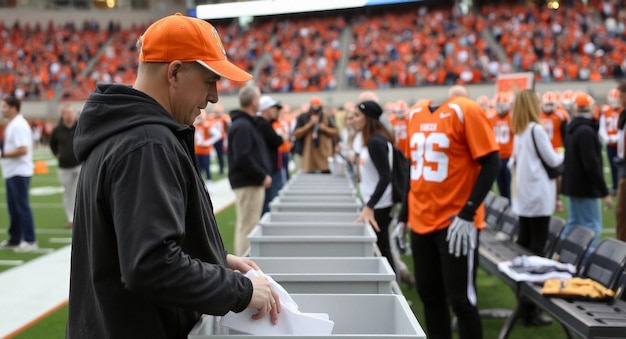Anúncios
As a devoted NFL fan, I’ve come to realize that the draft is not just a day on the calendar; it’s a pivotal event that can define the trajectory of a franchise. Each team, steeped in its own history and strategy, approaches the draft with distinct needs and aspirations. Understanding how teams can enhance their drafting strategy is crucial, not just for managers or analysts, but for every enthusiast wanting to grasp the game at a deeper level.
Thorough preparation is the key. It goes beyond just evaluating prospective players; it involves dissecting every facet of a team’s performance and needs. By analyzing historical data and understanding what has worked—or failed—in the past, teams can better position themselves to make impactful choices. The competitive advantage gained from meticulous planning can be the difference between a championship run and a lost season.
Anúncios
Now, as we dive into the intricacies of draft preparations, it’s clear that mastering the NFL draft by team strategy isn’t just an option; it’s essential for success in today’s league. Buckle up as we explore these vital components and unearth strategies that could reshape the future of a franchise.
Understanding the NFL Draft Process
Timing is crucial as teams have a limited window to prepare their draft boards before the event. The Draft features seven rounds, with each team aiming to maximize talent while adhering to salary cap restrictions. Recognizing trends, rival team strategies, and understanding player value are pivotal as teams navigate through choices. The significance of tailored, team-based strategies cannot be overstated, as they define the pathway to building a competitive roster, aligning choices with the overall vision for future seasons. Therefore, a comprehensive approach to evaluation and strategy formation is indispensable for NFL teams embarking on this pivotal endeavor.
Analyzing Team Needs
Anúncios
Teams often analyze past performance, injuries, and roster changes to establish their priorities. The San Francisco 49ers, for instance, targeted defensive depth in the 2019 draft, bolstering their already strong unit by selecting Nick Bosa, who made an immediate impact. By aligning draft strategies with immediate team needs, organizations can elevate their potential and success. The examination of previous drafts reveals patterns where teams emerge with players who not only fit their schemes but also fill critical gaps on their rosters.
Player Evaluation Techniques

Inspirational Perspective on Team Evaluation
“Success is where preparation and opportunity meet.” – Bobby Unser
Esta citação de Bobby Unser nos lembra que, assim como no processo de avaliação de jogadores para o draft da NFL, a preparação meticulosa e os dados coletados não são apenas números; eles representam as oportunidades que podem moldar o futuro de uma equipe. É um reflexo poderoso de que, com uma estratégia bem fundamentada e uma equipe dedicada, o sucesso está ao alcance. Cada métrica e cada scout são passos em direção a um potencial ilimitado.
Mock Drafts and Predictions
Mock drafts play a critical role in NFL team preparation, acting as a vital tool for executives and scouts alike. These simulated drafts allow teams to predict the behavior of rivals, assess player availability, and refine their own selection strategies. By creating numerous mock drafts, teams can evaluate a variety of scenarios, which helps in understanding potential impacts on their overall draft strategy.
Furthermore, predictions derived from expert analyses and fan engagement can provide insights into player performance and market trends. Such insights allow teams to tailor their decision-making processes, ensuring they are not only focused on available prospects but also considering how these players fit into their long-term vision. This strategic foresight can significantly enhance their drafting effectiveness and overall team performance.
Frequently Asked Questions (FAQ)
- 1. What are the most important factors teams consider when creating mock drafts?
- Teams often consider player rankings, team needs, potential trade opportunities, and the impact of rival teams’ selections.
- 2. How do expert analyses differ from fan predictions in mock drafts?
- Expert analyses are usually based on in-depth research and scouting reports, while fan predictions may reflect personal biases and trends rather than detailed evaluations.
- 3. Can mock drafts help teams anticipate trade possibilities during the actual draft?
- Yes, mock drafts can highlight potential trades by showing how team dynamics might shift based on player availability and needs.
- 4. How frequently do teams update their mock drafts leading up to the draft day?
- Teams often update their mock drafts regularly, especially in response to player performances, injuries, and other shifting dynamics in the lead-up to the draft.
- 5. What role do fan mock drafts play in NFL team strategies?
- Fan mock drafts can influence team strategies by showcasing public opinion on players, which might affect the team’s considerations of marketability and fan engagement.
Draft Day Strategies
On draft day, teams face an intricate web of choices that can define their future. The strategies implemented are not just about selecting the best available talent but rather a delicate dance of adaptability and real-time decision-making. Teams must constantly evaluate the shifting landscape as trades and selections unfold before them, making split-second adjustments to their pre-established plans.
The importance of having a flexible approach cannot be overstated. As prospects come off the board and unexpected moves occur, organizations must pivot quickly. This requires a deep understanding of their own roster needs, the positional value of players, and insights into rivals’ strategies.
Moreover, successful teams leverage data analytics to guide their decisions, balancing the old-school scouting methods with modern technology. This combination allows them to predict trends and make informed guesses about which players might slide down the draft board, thus seizing opportunities. Ultimately, the teams that thrive on draft day are those that remain poised, recognizing that adaptability is the greatest asset in the ever-changing dynamics of the NFL draft.
The Art of Adaptability in NFL Draft Strategies
Emphasizing adaptability can significantly influence the outcomes of draft day decisions.
